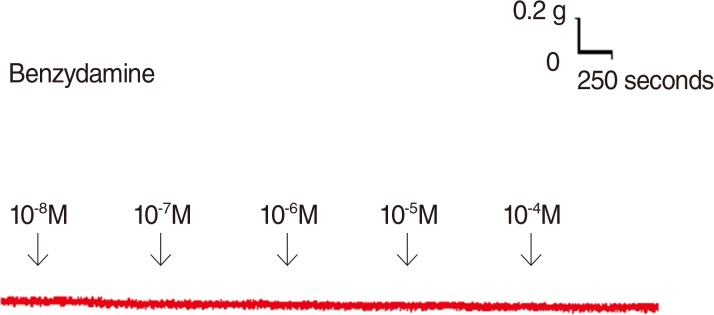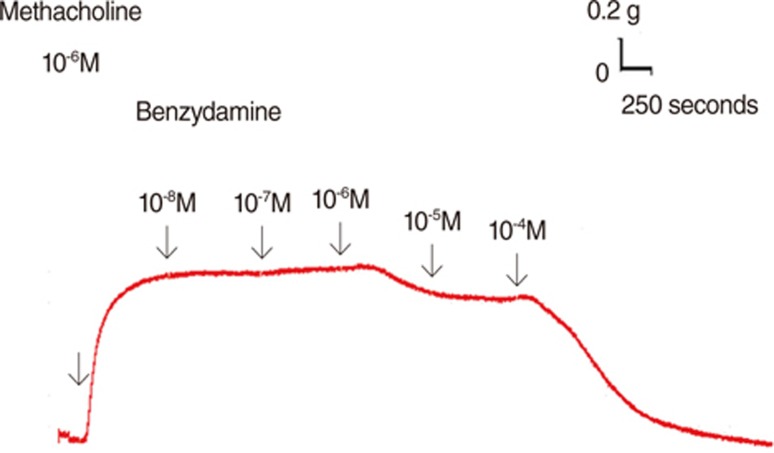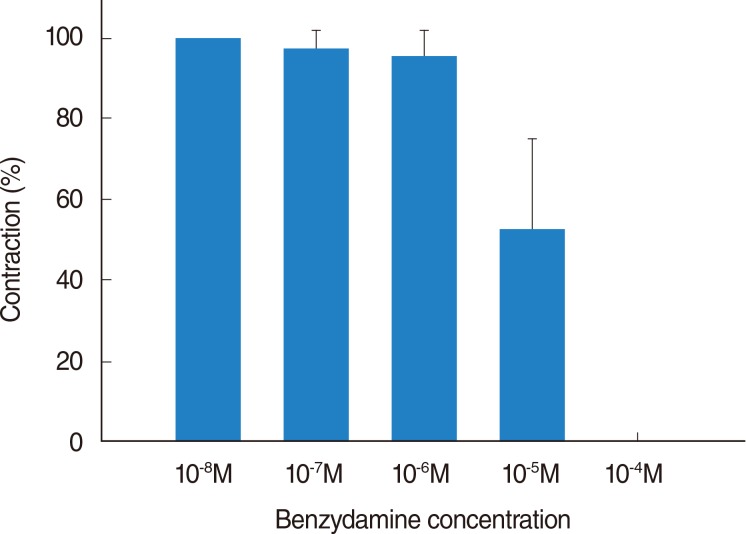Clin Exp Otorhinolaryngol.
2015 Mar;8(1):65-68. 10.3342/ceo.2015.8.1.65.
Benzydamine Oral Spray Inhibiting Parasympathetic Function of Tracheal Smooth Muscle
- Affiliations
-
- 1Department of Otolaryngology, Taipei Medical University-Shuang Ho Hospital, New Taipei, Taiwan. w0512n@ms15.hinet.net
- 2Graduate Institute of Clinical Medicine, Taipei Medical University College of Medicine, New Taipei, Taiwan.
- 3Department of Otolaryngology, Taipei Medical University-Wan Fang Hospital, Taipei, Taiwan.
- 4Graduate Institute of Medical Sciences and Department of Physiology, Taipei Medical University College of Medicine, New Taipei, Taiwan. jywang2010@tmu.edu.tw
- KMID: 1973490
- DOI: http://doi.org/10.3342/ceo.2015.8.1.65
Abstract
OBJECTIVES
Benzydamine is a nonsteroidal anti-inflammatory agents agent with anti-inflammatory and local anesthesia properties that is available in the entire world as an oral spray for oral mucositis patients who are suffering from radiation effects. The effect of benzydamine on oral mucositis in vivo is well known; however, the effect of the drug on tracheal smooth muscle has rarely been explored. During administration of the benzydamine for oral symptoms, it might affect the trachea via oral intake or inhalation.
METHODS
We examined the effectiveness of benzydamine on isolated rat tracheal smooth muscle. The following assessments of benzydamine were performed: effect on tracheal smooth muscle resting tension; effect on contraction caused by 10(-6)M methacholine as a parasympathetic mimetic; and effect of the drug on electrically induced tracheal smooth muscle contractions.
RESULTS
Addition of methacholine to the incubation medium caused the trachea to contract in a dose-dependent manner. Addition of benzydamine at doses of 10(-5)M or above elicited a significant relaxation response to 10(-6)M methacholine-induced contraction. Benzydamine could inhibit electrical field stimulation-induced spike contraction. It alone had a minimal effect on the basal tension of trachea as the concentration increased.
CONCLUSION
This study indicated that high concentrations of benzydamine might actually inhibit parasympathetic function of the trachea. Benzydamine might reduce asthma attacks in oral mucositis patients because it could inhibit parasympathetic function and reduce methacholine-induced contraction of tracheal smooth muscle.
Keyword
MeSH Terms
Figure
Reference
-
1. Turnbull RS. Benzydamine Hydrochloride (Tantum) in the management of oral inflammatory conditions. J Can Dent Assoc. 1995; 2. 61(2):127–134. PMID: 7600413.2. Fanaki NH, el-Nakeeb MA. Antimicrobial activity of benzydamine, a non-steroid anti-inflammatory agent. J Chemother. 1992; 12. 4(6):347–352. PMID: 1287137.
Article3. Alterio D, Jereczek-Fossa BA, Fiore MR, Piperno G, Ansarin M, Orecchia R. Cancer treatment-induced oral mucositis. Anticancer Res. 2007; Mar-Apr. 27(2):1105–1125. PMID: 17465250.4. Karavana SY, Guneri P, Ertan G. Benzydamine hydrochloride buccal bioadhesive gels designed for oral ulcers: preparation, rheological, textural, mucoadhesive and release properties. Pharm Dev Technol. 2009; 14(6):623–631. PMID: 19883251.5. Kazemian A, Kamian S, Aghili M, Hashemi FA, Haddad P. Benzydamine for prophylaxis of radiation-induced oral mucositis in head and neck cancers: a double-blind placebo-controlled randomized clinical trial. Eur J Cancer Care (Engl). 2009; 3. 18(2):174–178. PMID: 19267733.
Article6. Wang HW, Wang YT, Wu CC. A modified in vitro method for studyingtracheal smooth muscle response to drugs. J Med Sci. 2007; 10. 27(5):203–206.7. Kao CH, Chu YH, Wang HW. Effects of lidocaine on rat's isolated tracheal smooth muscle. Eur Arch Otorhinolaryngol. 2010; 5. 267(5):817–820. PMID: 19714348.
Article8. Bratton DL, Tanaka DT, Grunstein MM. Effects of temperature on cholinergic contractility of rabbit airway muscle. J Appl Physiol (1985). 1987; 11. 63(5):1933–1941. PMID: 3320012.
Article9. González O, Santacana GE. Effect of low temperature on tracheal smooth muscle contractile and relaxing responses evoked by electrical field stimulation. P R Health Sci J. 2001; 9. 20(3):237–244. PMID: 11776725.10. Yau KI, Hwang TL. The nonadrenergic noncholinergic system can modulate the effect of prokinetic agents on contractile response of isolated guinea-pig trachea segments to electrical field stimulation. J Formos Med Assoc. 2002; 10. 101(10):695–699. PMID: 12517043.11. Wang HW, Jackson RT. Do cholinergic neurons directly innervate nasal blood vessels? Rhinology. 1988; 6. 26(2):139–146. PMID: 3175457.
- Full Text Links
- Actions
-
Cited
- CITED
-
- Close
- Share
- Similar articles
-
- Evaluation of Thioperamide Effects Using Rat's Trachea Model
- Effects of benzydamine hydrochloride spray on postoperative sore throat associated with double-lumen endobronchial intubation: a double-blind, randomized controlled clinical trial
- The Effects of Heparin and Protamine on Contraction of Tracheal Smooth Muscle Induced by Carbachol in the Guinea Pig
- The Effects of Flumazenil and Verapamil on the Relaxation of Midazolam in Isolated Guinea-pig Tracheal Smooth Muscle
- The Effects of Mivacurium on Isolated Rat Tracheal Muscle






